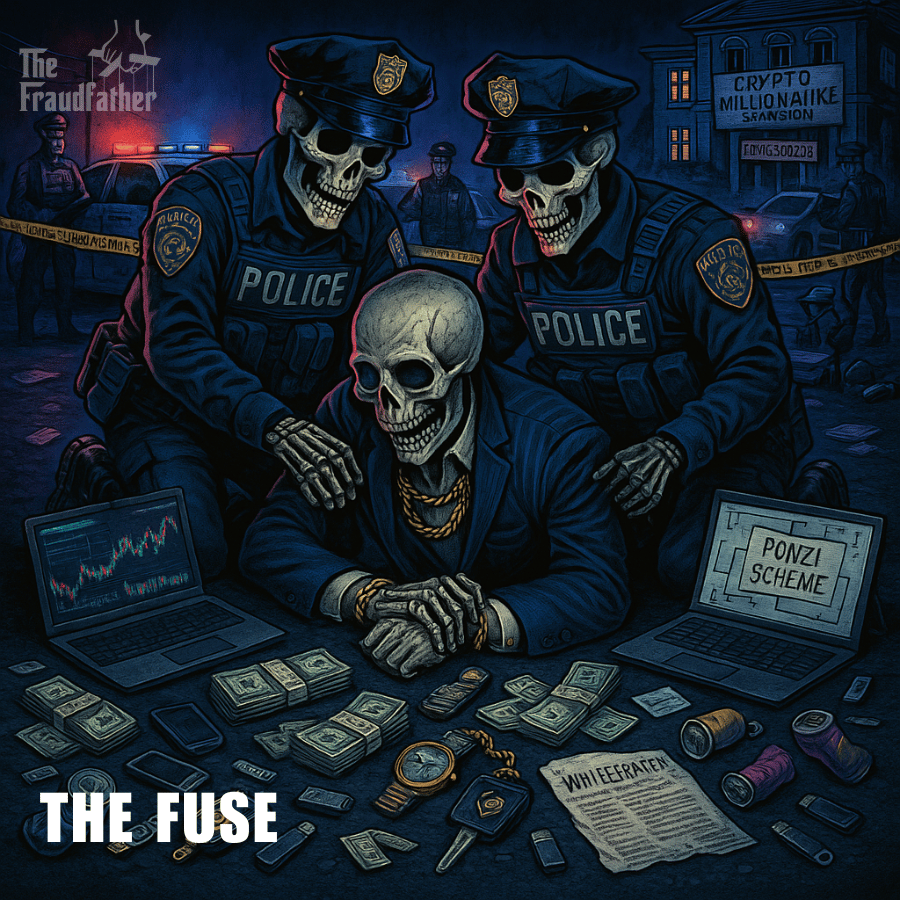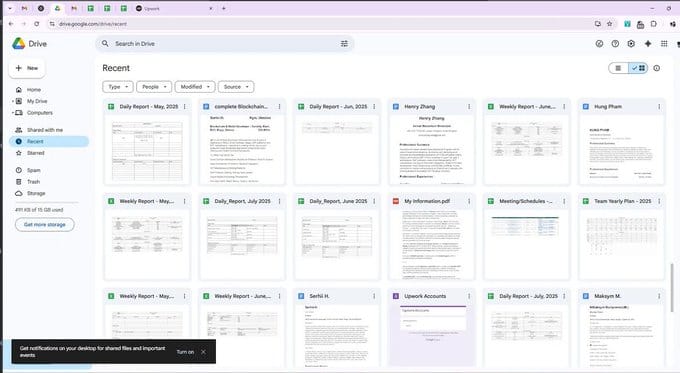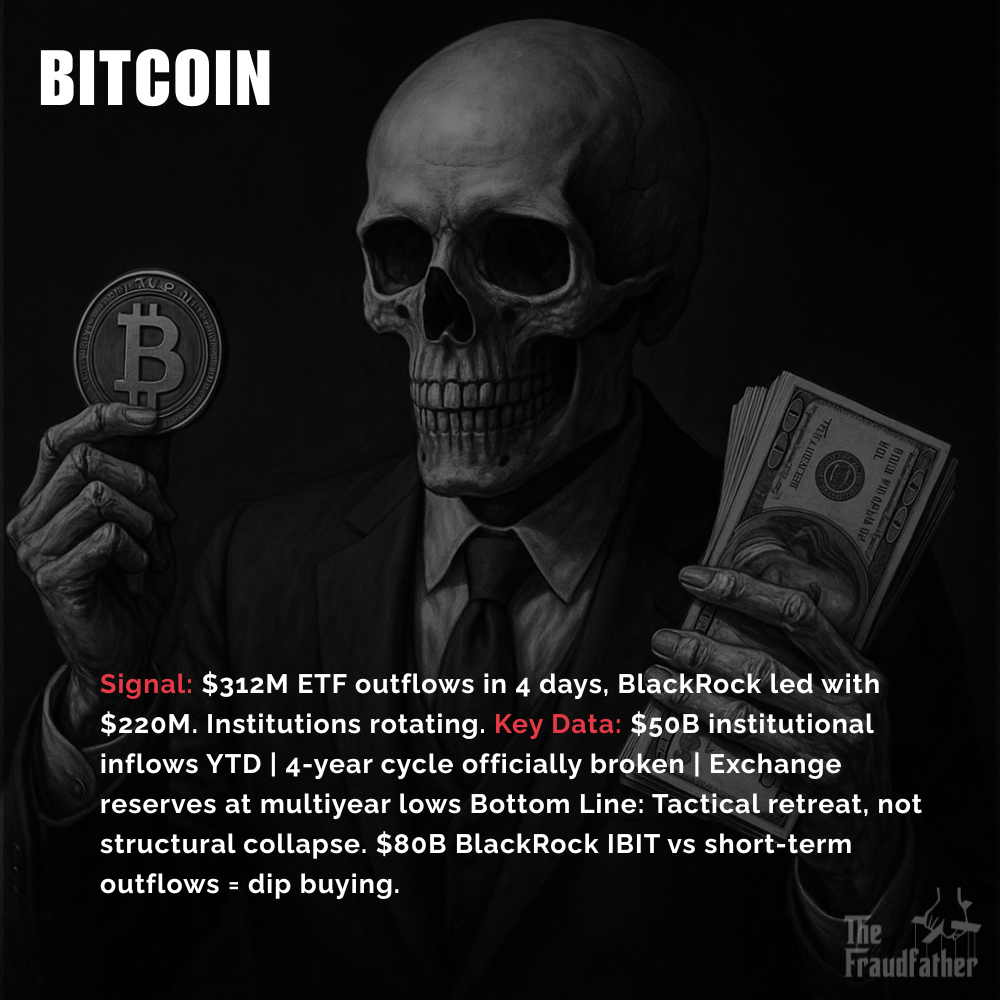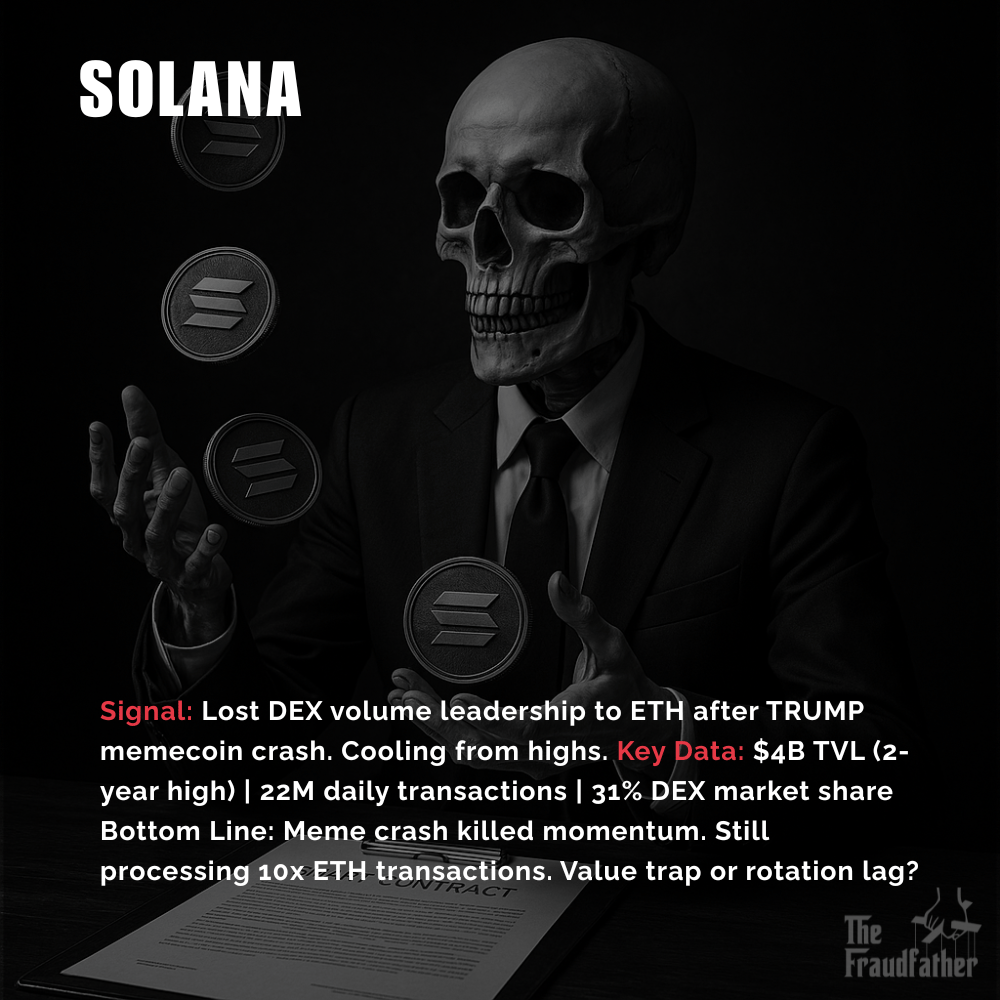- The KillChain
- Posts
- Why Every Path From Here Leads to Bitcoin
Why Every Path From Here Leads to Bitcoin
Powell's about to get steamrolled by math, and your Bitcoin position becomes the only lifeboat in a currency collapse


Powell's about to get steamrolled by math, and your Bitcoin position becomes the only lifeboat in a currency collapse
GM. You're reading KillChain, the tactical brief trusted by digital sleuths, fraud hunters, and crypto insiders who know the real game isn't DeFi or CeFi; it's deception.
We track the wallets, decode the scams, and expose the plays fraudsters pray you'll miss. This isn't crypto news. It's threat intelligence. We're the last line of defense between your protocol and the wolves, your tactical edge in a world where trust is just another exploit.
The Fed's Mathematical Death Trap: Why Powell Can't Win
Jerome Powell is trapped in a corner that decades of monetary engineering finally built around him. Every move he makes from here accelerates the dollar's destruction and Bitcoin's inevitable victory.
Why KillChain Readers Need to Understand This:
You might think Federal Reserve policy is boring central bank theater. Wrong. What happens in the next 6 months determines whether your Bitcoin position makes you wealthy or just wealthier
The Fed is facing what mathematicians call a "no-win scenario." Trump wants 300 basis points in rate cuts. The economy is fracturing under $37 trillion in debt. Inflation is already creeping back at 2.8% regardless of what Powell does.
Here's the reality: Both paths lead to currency debasement. Both paths lead to Bitcoin's ascension. The only question is speed.
This isn't speculation. It's mathematical certainty disguised as monetary policy.
The Impossible Choice: Cut Rates or Watch Everything Burn
Path One: Powell Caves (The Fast Track to Hyperinflation)
If Powell bends the knee and delivers Trump's demanded 300 basis point cut, we're looking at economic violence on a scale that makes 2008 look like a practice run.
The Numbers Don't Lie:
Core inflation explodes to 4%+ by 2026 (higher than post-COVID peak of 5.3%)
Dollar index crashes below 90 as foreign central banks dump Treasuries
10-year yields spike past 5.5%, breaking the bond bull market that's propped up pensions since 1981
Debt servicing costs hit $2 trillion annually 6% of entire GDP just to service existing debt

Core inflation explodes to 4%+ by 2026 (higher than post-COVID peak of 5.3%)
But here's the real kicker: The Fed loses institutional independence forever. If Trump successfully pressures Powell out and installs a compliant chair, global markets will recognize that American monetary policy has become a political weapon.
Turkey tried this. Central bank independence died, inflation hit 35%, and the currency became toilet paper. The research is clear: when you destroy monetary credibility, borrowing costs explode and investment capital flees.
Path Two: Powell Holds Firm (The Slow-Motion Catastrophe)
Even if Powell maintains rates and preserves some Fed credibility, inflation is coming anyway. The damage has already been baked into the system through two unstoppable forces:
Trump's Tariff Tsunami: Nearly two-thirds of manufacturers now attribute rising costs to tariffs. Services input prices jumped from 59.7 to 61.4 in July, one of the largest increases in three years. As S&P Global's chief economist warned: "The rise in selling prices suggests consumer inflation will rise further above the Fed's 2% target."
The "Big Beautiful Bill" Fiscal Bomb: The IMF is already warning that this combination of increased spending and tax cuts "runs counter to reducing federal debt" and risks destabilizing public finances. When this fiscal explosion hits the real economy, inflation accelerates regardless of Fed policy.
Even in this "moderate" scenario:
Core inflation still climbs to 3.2%
Treasury yields hit 4.7% by summer 2026
Debt servicing costs reach $1.6 trillion (4.5% of GDP)
Dollar continues death spiral with Morgan Stanley predicting DXY at 91
The Stress Indicators Are Screaming Red
The U.S. economy might be "growing on paper," but the underlying stress fractures are impossible to ignore:
Dollar down 10%+ since January while the Fed claims victory over inflation
Core PCE stuck at 2.8% despite aggressive tightening campaign
July PPI surged 0.9% triple expectations and accelerating
$37 trillion debt load with 10-year yields at 4.33% creating unsustainable math
The Federal Reserve's Jackson Hole symposium isn't monetary policy discussion. It's damage control for an institution that painted itself into a corner where every option leads to currency destruction.
Bitcoin's Mathematical Victory Condition
Here's what the financial establishment hopes you miss: Bitcoin wins in both scenarios.
Scenario One (Rapid Rate Cuts):
Bitcoin surges immediately alongside gold and stocks as real interest rates go negative. With Fed independence destroyed and currency debasement accelerating, Bitcoin becomes the obvious safe haven from monetary chaos.
Scenario Two (Gradual Collapse):
Bitcoin might consolidate through 2025, but as the dollar weakens and deficits explode, non-sovereign assets become irresistible. Bitcoin's value proposition shifts from tech speculation to systemic insurance.
The Pattern Recognition: Every major currency crisis in history follows the same playbook:
Unsustainable debt loads create impossible fiscal math
Political pressure forces monetary accommodation
Currency credibility collapses faster than anyone expects
Hard assets surge as people flee debasement
We're watching this playbook unfold in real-time. The only question is whether you position for it or become a victim of it.
Your Tactical Response: How to Profit From Inevitable Collapse
The traditional financial advice of "diversified portfolios" and "dollar-based savings" is about to get stress-tested by mathematical reality. Here's your survival playbook:
Immediate Actions:
Scale Into Bitcoin: Don't wait for mainstream media confirmation, by then you're buying the top. Every dollar in traditional savings accounts is a bet that central bankers suddenly discover fiscal discipline. History suggests this bet has never paid off.
Understand the Mathematical Certainty: This isn't speculation about Fed policy. It's recognizing that debt-to-GDP ratios, inflation dynamics, and political pressures create scenarios where hard assets must outperform fiat debasement. Bitcoin is the most liquid, portable, and uncensorable of these assets.
Prepare for Extreme Volatility: Bitcoin will experience violent swings as markets process these macro changes. The sophisticated money understands that short-term volatility is tuition for long-term wealth preservation.
Strategic Positioning:
Diversify Beyond Dollar-Denominated Assets: Real estate, commodities, stocks, and crypto all benefit from currency debasement. The key is holding assets that can't be printed or politically manipulated.
Build Cash Reserves for Tactical Opportunities: When volatility accelerates, you want dry powder to buy fear. Keep enough cash to capitalize on panic selling while maintaining core hard asset positions.
Prepare for System-Level Changes: This isn't just about investment returns. We're potentially watching the end of dollar hegemony and the birth of alternative monetary systems. Position accordingly.
The Historical Pattern Is Crystal Clear
Every empire that debased its currency followed the same mathematical progression:
Unsustainable spending creates debt crises
Political pressure forces monetary accommodation
Currency loses credibility faster than policy makers expect
Hard assets surge as citizens flee debasement
Rome debased silver denarii. Weimar printed marks. Zimbabwe printed dollars. Venezuela printed bolivars.
The names change. The mathematics don't.
The U.S. has $37 trillion in debt, $2 trillion annual deficits, and political leaders demanding easier money to fund bigger spending. The pattern recognition couldn't be clearer.
Why This Time Really Is Different (And Why That's Terrifying)
Previous currency crises were regional. Dollar collapse is global. When the world's reserve currency loses credibility, there's nowhere to hide in traditional financial assets.
Except Bitcoin.
For the first time in monetary history, we have a completely non-sovereign, mathematically scarce, globally liquid alternative to political currencies. Central bankers can print dollars, euros, and yen. They can't print Bitcoin.
The Fed's impossible choice becomes Bitcoin's inevitable victory.
Bottom Line: Mathematical Certainty Disguised as Policy Uncertainty
Whether Powell cuts rates aggressively or holds firm, America is locked into an inflationary trajectory. Trump's fiscal policies guarantee upward price pressure. The debt dynamics ensure sound money policy is politically impossible.
Bitcoin isn't just positioned for this outcome; it was designed for it.
While traditional investors debate whether we'll have inflation or deflation, the mathematically literate are positioning for the only outcome that makes sense: systematic currency debasement and the rise of alternative monetary systems.
The Fed's dead cat bounce is your opportunity.
The house always wins until someone changes the game. Bitcoin is changing the game. Position accordingly.
KillChain doesn't provide investment advice. We provide mathematical analysis of rigged systems. Every financial decision involves risk. Do your research, trust the math, and remember: empires fall when their currencies fail.
Business as usual? No thanks.
The problem with most business news? It’s too long, too boring, and way too complicated.
Morning Brew fixes all three. In five minutes or less, you’ll catch up on the business, finance, and tech stories that actually matter—written with clarity and just enough humor to keep things interesting.
It’s quick. It’s free. And it’s how over 4 million professionals start their day. Signing up takes less than 15 seconds—and if you’d rather stick with dense, jargon-packed business news, you can always unsubscribe.

Wall Street's latest power play isn't about protecting consumers. It's about protecting their profits.
How Wall Street is Rigging the Game Against Your Financial Freedom
While American families struggle with inflation and seek better returns on their savings, traditional banks are working behind closed doors to crush competition that might actually benefit ordinary people. The battleground? The newly passed GENIUS Act, which governs stablecoin regulation in the United States.
The Banking Industry's Fear Campaign
Leading banking groups, spearheaded by the American Bankers Association and the Bank Policy Institute, are pushing Congress to gut key provisions of the GENIUS Act. Their weapon of choice? Fear-mongering about a supposed "loophole" that could allow stablecoin users to earn yields on their digital assets.
The banks claim this could drain $6.6 trillion from traditional bank deposits, threatening the flow of credit to households and businesses. But let's examine what's really happening here: banks are terrified that consumers might discover they have alternatives to the measly interest rates offered by traditional savings accounts.
What Banks Don't Want You to Know
While your local bank pays you virtually nothing on your savings account, often less than 1% annually, yield-bearing stablecoins have already distributed over $800 million in returns to holders. In just the past month, platforms like Ethena and Securitize have delivered millions in payouts to users who chose innovation over stagnation.
The banking lobby argues that stablecoins shouldn't be able to offer yields because they're not subject to the same regulatory framework as traditional deposits. This is rich coming from an industry that has spent decades finding creative ways to charge consumers fees while offering minimal returns on their money.
The Innovation Strangulation Strategy
The crypto industry's response has been swift and pointed. The Crypto Council for Innovation and the Blockchain Association fired back in a joint letter to the Senate Banking Committee, accusing banks of trying to "re-litigate issues already settled in months of negotiations."
Their argument cuts to the heart of the matter: "Payment stablecoins are not bank deposits, or money market funds, or investment products, and thus they are not regulated in the same way. Unlike bank deposits, payment stablecoins are not used to fund loans."
This distinction is crucial. Banks use your deposits to make loans and profit from the spread, while offering you pennies in return. Stablecoins operate differently; they're backed by reserves and don't fund the same lending activities that banks use to justify their tight grip on consumer deposits.
The Real Numbers Tell a Different Story
Despite the banking industry's apocalyptic warnings, the data suggests their fears are overblown, or deliberately exaggerated. The total stablecoin market cap currently sits at $288 billion, which sounds massive until you realize it's a tiny fraction of the $22 trillion US dollar money supply reported by the Federal Reserve.
Moreover, a July 2025 analysis by Charles River Associates found no significant link between stablecoin growth and bank deposit outflows. If stablecoins were truly the existential threat banks claim, wouldn't we see more dramatic evidence in the data?
The Interstate Commerce Smokescreen
Banks are also pushing to eliminate Section 16(d) of the GENIUS Act, which allows subsidiaries of state-chartered institutions to conduct stablecoin business across state lines without additional licensing. The crypto advocacy groups warn that removing this provision would recreate "the same fragmented, balkanized regulatory regime that stifles interstate commerce."
This move would effectively create a maze of state-by-state regulations that would benefit large, established banks while crushing smaller competitors and innovative startups. It's a classic example of using regulatory complexity as a moat to protect incumbent profits.
The Bottom Line for Consumers
At its core, this battle isn't about financial stability or consumer protection, it's about preserving a system that has enriched banks at consumers' expense for generations. Traditional banks have had decades to innovate and offer competitive returns to savers. Instead, they've chosen to focus on fees, complex products, and maintaining their regulatory advantages.
The GENIUS Act, as currently written, creates space for genuine innovation that could benefit consumers through better returns and more financial choices. The banking lobby's attempt to gut these provisions should be seen for what it really is: an effort to maintain their monopoly on American savings, regardless of what's best for the people whose money they hold.
As lawmakers consider these proposed changes, they should ask themselves a simple question: Are we protecting consumers, or are we protecting banks from having to compete for consumers' business? The answer will determine whether American savers get access to 21st-century financial tools or remain trapped in a system designed to enrich Wall Street at their expense.
Your Move: Don't Let Them Win
This isn't just about cryptocurrency or technical regulations, it's about your right to earn a fair return on your own money. Here's what you need to do:
Contact your representatives immediately. Find your senators and House members at congress.gov and tell them to reject any banking lobby attempts to gut the GENIUS Act. Make it clear that you want competition in financial services, not protection for bank profits.
Spread the word. Share this story with friends and family who are tired of earning nothing on their savings while banks rake in record profits. The banking lobby has millions in lobbying dollars; we have numbers and the truth.
Vote with your wallet. Start exploring stablecoin options and decentralized finance platforms that actually reward you for your deposits. Every dollar you move away from traditional banks is a vote for innovation over stagnation.
The window to act is closing fast. Banking lobbyists are working overtime to kill this competition before it threatens their profit margins. Don't let them succeed in rigging the game against you, again.

Because the real explosions are the scams you never saw coming.
Blast #1: Counter-Hack Exposes North Korean "Alex Hong" Running $680K Inside Job at Favrr
What Blew Up: A team of five North Korean IT workers operated 30+ fake identities to infiltrate crypto companies as developers, with their CTO "Alex Hong" orchestrating the $680,000 Favrr marketplace exploit in June 2025. The operation was exposed when an unnamed white-hat hacker counter-hacked their devices, revealing Google Drive exports, expense spreadsheets, and browser history showing systematic infiltration of the crypto industry through fraudulent job applications.

Google Workspace is extensively used by them to organize their TTPs with communications primarily in English. Credit: ZachXBT
How They Wired the Charge:
Device compromise revelations: Anonymous source successfully hacked North Korean operative's computer on August 13, 2025, providing unprecedented access to Google Drive exports, Chrome browser profiles, and device screenshots showing complete operational playbook
Systematic identity manufacturing: Team maintained detailed spreadsheets tracking 30+ fake personas including "Alex Hong," complete with forged government IDs, purchased LinkedIn accounts, Upwork profiles, and scripted interview responses claiming experience at OpenSea and Chainlink
Inside job execution: Rather than external hacking, operatives secured legitimate developer positions at crypto companies, with "Alex Hong" becoming Favrr's chief technology officer before orchestrating the June 2025 $680,000 exploit from inside company systems

Scrips used for “Alex Hong” Credit: ZachXBT
Wallet infrastructure exposed: Primary wallet address 0x78e1a4781d184e7ce6a124dd96e765e2bea96f2c directly linked to Favrr exploit and multiple other crypto project infiltrations, with Payoneer accounts converting fiat payments to crypto through systematic laundering
Operational expense tracking: May 2025 expenses totaled $1,489.8 covering fake SSNs, AI subscriptions, VPNs, proxy services, and computer rentals, with weekly team reports showing operatives struggling with job requirements: "I can't understand job requirement, and don't know what I need to do"
Attribution confirmation: Browser history revealed frequent Google Translate usage for Korean translations while operating from Russian IP addresses, with searches for "top AI development companies in Europe" and questions about ERC-20 token deployment on Solana indicating future targeting intelligence
KillChain Blast Assessment: This represents the evolution of state-sponsored crypto attacks from external exploitation to systematic internal infiltration. The North Korean team's $680,000 Favrr success demonstrates how traditional hiring negligence becomes a national security vulnerability when combined with sophisticated identity fabrication. The counter-hack revelation that multiple crypto projects discovered their CTOs and senior developers were DPRK operatives using false credentials exposes systemic industry-wide compromise affecting private repositories, smart contract audits, and financial data across the ecosystem.

North Korean Crypto Scammers Getting Busted
Your Blast Shield: Implement immediate verification procedures for all remote developers, especially those with recently created professional profiles or unverifiable work histories. Legitimate blockchain developers have verifiable GitHub contribution histories, can be reference-checked through known industry contacts, and don't have LinkedIn profiles that get hastily deleted when questioned. If a developer claims experience at major projects like OpenSea or Chainlink but their background can't be independently verified, you're hiring a potential state actor, not a legitimate employee.
The following ETH addresses received funds connected to the North Korean infiltration network:
Primary Operations Wallet:
0x78e1a4781d184e7ce6a124dd96e765e2bea96f2c
Warning: This address remains active and continue to be monitored by blockchain investigators. Any interaction with these wallets should be immediately reported to relevant authorities and blockchain security firms.

This isn't a dashboard. This is a tactical briefing, peeling back the layers on the market's core assets.
Battlefield Intelligence: What the Numbers Truly Reveal.
Bitcoin (BTC) - $116,828

Data Pull: 22 August 2025
Ethereum (ETH) - $4,832

Data Pull: 22 August 2025
Solana (SOL) - $181

Data Pull: 22 August 2025
⚠️ The KillChain Disclaimer ⚠️
Informational & Educational Use Only
All content in this newsletter, including but not limited to market commentary, tactical read-outs, “buy-zone” language, and any linked training materials, is provided strictly for general, educational, and informational purposes. Nothing herein constitutes (or should be interpreted as) personalized investment, legal, accounting, or tax advice.
No Investment Recommendations
References to “accumulate,” “scale in,” “trim,” or similar calls to action are illustrative frameworks, not specific recommendations to buy, sell, or hold any digital asset, security, or derivative. You alone are responsible for evaluating the merits and risks associated with any use of the information provided before making any investment or trading decision. Consult a registered investment adviser or other qualified professional regarding your individual circumstances.

About the FraudFather:
The Fraudfather didn’t learn fraud from influencers or movies. He learned it chasing terrorists, flipping money launderers, and dismantling multi-million-dollar schemes, before most people knew what “DeFi” meant.
A former Senior Special Agent and Supervisory Intelligence Operations Officer, he spent over two decades tracking financial predators across borders, blockchains, and bureaucracies. From dark web forums to government war rooms, he’s seen every lie and loophole up close.
Now a “recovering” digital identity and cybersecurity executive, he’s turned his sights to teaching crypto, where old scams wear new skins, and smart contracts get played like slot machines.
Through The Fraudfather persona, he’s exposing how fraud really works on-chain:
How social engineers bypass wallet security
How cross-chain laundering pipelines stay hidden
How scammers weaponize human psychology faster than regulators can blink
This isn’t theory.
It’s operational intelligence, on-chain and in near real time.
Follow the Fraudfather and stay five moves ahead of the next exploit

